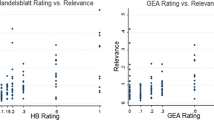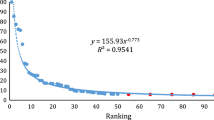Abstract
Evaluating the scholarly reputation of journals has become one of the key concerns and research focuses in academia. The scholarly performance of a journal’s editorial team helps to enhance the journal’s academic impact. This paper develops an editorial team scholarly index from the new perspective of journal editorship, combining the editors’ scholarly performance and the editors’ titles (e.g., associate, assistant) to provide an alternative indicator for evaluating academic journal reputation. This index is useful to measure and rank journals, especially new journals. The paper classifies journal editorial teams and evaluates academic journals using data for 738 members of editorial teams for 21 well-known journals in the field of library and information science. The study concludes that the new index has a significantly positive relationship with journal reputation and shows that the journals’ rankings according to the new index are neither far away from nor uselessly close to the four baseline indicators traditionally measuring journal reputation. Finally, the research finds that there are significant positive correlations between journal reputation and the new index when three different levels of titles of editors are considered, and a comparative empirical analysis of the title levels is provided.
Similar content being viewed by others
References
Andrikopoulos, A., & Economou, L. (2015). Editorial board interlocks in financial economics. International Review of Financial Analysis, 37, 51–62.
Asnafi, S., Gunderson, T., McDonald, R. J., & Kallmes, D. F. (2017). Association of h-index of editorial board members and impact factor among radiology journals. Academic Radiology, 24(2), 119–123.
Baccini, A., & Barabesi, L. (2011). Seats at the table: The network of the editorial boards in information and library science. Journal of Informetrics, 5(3), 382–391.
Bedeian, A. G., Van Fleet, D. D., & Hyman, H. H. (2009). Scientific achievement and editorial board membership. Organizational Research Methods, 12(2), 211–238.
Besancenot, D., Huynh, K. V., & Faria, J. R. (2012). Search and research: The influence of editorial boards on journals’ quality. Theory and Decision, 73(4), 687–702.
Braun, T., Dióspatonyi, I., Zsindely, S., & Zádor, E. (2007). Gatekeeper index versus impact factor of science journals. Scientometrics, 71(3), 541–543.
Braun, T., Glänzel, W., & Schubert, A. (2006). A Hirsch-type index for journals. Scientometrics, 69(1), 169–173.
Burgess, T. F., & Shaw, N. E. (2010). Editorial board membership of management and business journals: A social network analysis study of the financial times 40. British Journal of Management, 21(3), 627–648.
Cai, L., Tian, J., Liu, J., Bai, X., Lee, I., Kong, X., et al. (2019). Scholarly impact assessment: A survey of citation weighting solutions. Scientometrics, 118(2), 453–478.
Callaway, E. (2016). Publishing elite turns against impact factor. Nature, 535(7611), 210–211.
Chan, K. C., & Fok, R. C. (2003). Membership on editorial boards and finance department rankings. Journal of Financial Research, 26(3), 405–420.
da Silva, J. A. T., & Al-Khatib, A. (2017). How are editors selected, recruited and approved? Science and Engineering Ethics, 23(6), 1801–1804.
Faria, J. R. (2005). The game academics play: Editors versus authors. Bulletin of Economic Research, 57(1), 1–12.
Finlay, S. C., Ni, C., Tsou, A., & Sugimoto, C. R. (2013). Publish or practice? An examination of librarians’ contributions to research. portal: Libraries and the Academy, 13(4), 403–421.
Frey, B. S., & Rost, K. (2010). Do rankings reflect research quality? Journal of Applied Economics, 13(1), 1–38.
García-Carpintero, E., Granadino, B., & Plaza, L. M. (2010). The representation of nationalities on the editorial boards of international journals and the promotion of the scientific output of the same countries. Scientometrics, 84(3), 799–811.
Giménez-Toledo, E., Román-Román, A., Perdiguero, P., & Palencia, I. (2009). The editorial boards of Spanish scholarly journals: What are they like? What should they be like? Journal of Scholarly Publishing, 40(3), 287–306.
Glänzel, W. (2006). On the opportunities and limitations of the H-index. Science Focus, 1(1), 10–11. English version retrieved from http://eprints.rclis.org/9378/1/H_Index_opprtunities.pdf.
Hirsch, J. E. (2005). An index to quantify an individual’s scientific research output. Proceedings of the National Academy of Sciences of the United States of America, 102(46), 16569–16572.
Hirsch, J. E. (2019). hα: An index to quantify an individual’s scientific leadership. Scientometrics, 118(2), 673–686.
Kay, J., Memon, M., de Sa, D., Simunovic, N., Duong, A., Karlsson, J., et al. (2017). The h-index of editorial board members correlates positively with the impact factor of sports medicine journals. Orthopaedic Journal of Sports Medicine, 5(3), 2325967117694024.
Konrad, A. M. (2008). Knowledge creation and the journal editor’s role. In Y. Baruch, A. M. Konrad, H. Aguinis, & W. H. Starbuck (Eds.), Opening the black box of editorship (pp. 3–15). New York: Palgrave MacMillan.
Lowe, D. J., & Van Fleet, D. D. (2009). Scholarly achievement and accounting journal editorial board membership. Journal of Accounting Education, 27(4), 197–209.
Mauleón, E., Hillán, L., Moreno, L., Gómez, I., & Bordons, M. (2013). Assessing gender balance among journal authors and editorial board members. Scientometrics, 95(1), 87–114.
Mazov, N. A., & Gureev, V. N. (2016). The editorial boards of scientific journals as a subject of scientometric research: A literature review. Scientific and Technical Information Processing, 43(3), 144–153.
Mendonça, S., Pereira, J., & Ferreira, M. E. (2018). Gatekeeping African studies: What does “editormetrics” indicate about journal governance? Scientometrics, 117(3), 1513–1534.
Metz, I., Harzing, A. W., & Zyphur, M. J. (2016). Of journal editors and editorial boards: Who are the trailblazers in increasing editorial board gender equality? British Journal of Management, 27(4), 712–726.
Mingers, J., & Yang, L. (2017). Evaluating journal quality: A review of journal citation indicators and ranking in business and management. European Journal of Operational Research, 257(1), 323–337.
Mukaka, M. M. (2012). A guide to appropriate use of correlation coefficient in medical research. Malawi Medical Journal, 24(3), 69–71.
Nisonger, T. (2002). The relationship between international editorial board composition and citation measures in political science, business, and genetics journals. Scientometrics, 54(2), 257–268.
Oleinik, A. (2014). Conflict (s) of interest in peer review: Its origins and possible solutions. Science and Engineering Ethics, 20(1), 55–75.
Pagel, P. S., & Hudetz, J. A. (2011). Bibliometric analysis of anaesthesia journal editorial board members: Correlation between journal impact factor and the median h-index of its board members. British Journal of Anaesthesia, 107(3), 357–361.
Paulus, F. M., Cruz, N., & Krach, S. (2018). The impact factor fallacy. Frontiers in Psychology, 9, 1487.
Petersen, J., Hattke, F., & Vogel, R. (2017). Editorial governance and journal impact: A study of management and business journals. Scientometrics, 112(3), 1593–1614.
Resnik, D. B., & Elmore, S. A. (2016). Ensuring the quality, fairness, and integrity of journal peer review: A possible role of editors. Science and Engineering Ethics, 22(1), 169–188.
Roth, W. M. (2002). Editorial power/authorial suffering. Research in Science Education, 32(2), 215–240.
Straub, D., & Anderson, C. (2010). Journal quality and citations: Common metrics and considerations about their use. MIS Quarterly, 34(1), iii–xii.
Teixeira, E. K., & Oliveira, M. (2018). Editorial board interlocking in knowledge management and intellectual capital research field. Scientometrics, 117(3), 1853–1869.
Tsui, A. S., & Hollenbeck, J. R. (2009). Successful authors and effective reviewers: Balancing supply and demand in the organizational sciences. Organizational Research Methods, 12(2), 259–263.
Walters, W. H. (2016). The research contributions of editorial board members in library and information science. Journal of Scholarly Publishing, 47(2), 121–146.
Walters, W. H. (2017a). Citation-based journal rankings: Key questions, metrics, and data sources. IEEE Access, 5, 22036–22053.
Walters, W. H. (2017b). Do subjective journal ratings represent whole journals or typical articles? Unweighted or weighted citation impact? Journal of Informetrics, 11(3), 730–744.
Walters, W. H., & Wilder, E. I. (2016). Disciplinary, national, and departmental contributions to the literature of library and information science, 2007–2012. Journal of the Association for Information Science and Technology, 67(6), 1487–1506.
Wu, D., Li, J., Lu, X., & Li, J. (2018). Journal editorship index for assessing the scholarly impact of academic institutions: An empirical analysis in the field of economics. Journal of Informetrics, 12(2), 448–460.
Zdeněk, R. (2018). Editorial board self-publishing rates in Czech economic journals. Science and Engineering Ethics, 24(2), 669–682.
Zdeněk, R., & Lososová, J. (2018). An analysis of editorial board members’ publication output in agricultural economics and policy journals. Scientometrics, 117(1), 563–578.
Zhang, J., Zhao, Y., & Wang, Y. (2016). A study on statistical methods used in six journals of library and information science. Online Information Review, 40(3), 416–434.
Zsindely, S., Schubert, A., & Braun, T. (1982). Editorial gatekeeping patterns in international science journals: A new science indicator. Scientometrics, 4(1), 57–68.
Acknowledgements
This research was supported by the National Natural Science Foundation of China (Grants 71874173 and 71273250) and the Academic Division of Mathematics and Physics of the Chinese Academy of Sciences (Grant No. 2018-M04-B-004). We would like to thank the editor and anonymous reviewers for their constructive comments and suggestions, which helped us to improve the paper.
Author information
Authors and Affiliations
Corresponding author
Rights and permissions
About this article
Cite this article
Xie, Y., Wu, Q. & Li, X. Editorial team scholarly index (ETSI): an alternative indicator for evaluating academic journal reputation. Scientometrics 120, 1333–1349 (2019). https://doi.org/10.1007/s11192-019-03177-x
Received:
Published:
Issue Date:
DOI: https://doi.org/10.1007/s11192-019-03177-x




